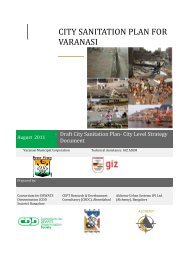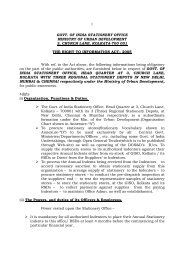CITY SANITATION PLAN - Ministry of Urban Development
CITY SANITATION PLAN - Ministry of Urban Development
CITY SANITATION PLAN - Ministry of Urban Development
Create successful ePaper yourself
Turn your PDF publications into a flip-book with our unique Google optimized e-Paper software.
Pros and Cons<br />
<strong>CITY</strong> <strong>SANITATION</strong> <strong>PLAN</strong> BAREILLY<br />
Operation and maintenance costs can be high, especially where pumping is required or silt and other<br />
solids cannot effectively be excluded from the sewer. As a result, many service providers rely upon<br />
subsidies to keep the system functional.<br />
Sewers <strong>of</strong>ten become heavily silted and lose hydraulic capacity or become completely<br />
blocked.<br />
Illegal storm water collections may lead to hydraulic overload <strong>of</strong> the sewerage system during<br />
heavy rainfall events. This may result in the flow <strong>of</strong> run<strong>of</strong>f contaminated with excreta<br />
flowing in streets and sometimes houses.<br />
In order to save electricity costs, pumping station operators <strong>of</strong>ten maintain wastewater<br />
levels in the wet well above the invert level <strong>of</strong> the incoming sewer. This reduces flow<br />
velocities in the incoming sewer and leads to rapid siltation.<br />
In many cases a sewerage system is built in isolation from the sewage treatment plant and<br />
the two do not connect.<br />
Households may not connect their facilities to the sewer network due to high connection<br />
charges and low willingness to pay.<br />
Simplified Sewers or Shallow Sewers<br />
Application Level- Neighborhood and City Wide<br />
Simplified Sewers describe a sewerage network that is constructed using smaller diameter pipes laid<br />
at a shallower depth and at a flatter gradient than conventional sewers. The Simplified Sewer allows<br />
for a more flexible design associated with lower costs and a higher number <strong>of</strong> connected<br />
households. Expensive manholes are replaced with simple inspection chambers. Each discharge<br />
point is connected to an interceptor tank to prevent settle-able solids and trash from entering the<br />
sewer. As well, each household should have a grease trap before the sewer connection.<br />
Another key design feature is that the sewers are laid within the property boundaries, rather than<br />
beneath the central road. Because the sewers are more communal, they are <strong>of</strong>ten referred to as<br />
condominium sewers. Oftentimes, the community will purchase, and connect to, a single legal<br />
connection to the main sewer; the combined effluent <strong>of</strong> the auxiliary sewer network flows into the<br />
main sewer line. Because simplified sewers are laid on or around the property <strong>of</strong> the users, higher<br />
ADMINISTRATIVE STAFF COLLEGE OF INDIA, HYDERABAD Page 157
















